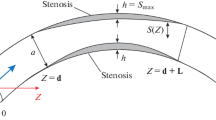Abstract:
Pulsatile flow through the three-dimensional carotid artery bifurcation has been studied using the artificial-compressibility method. The part of the flow with large inertia bifurcates and creates a very steep velocity gradient on the divider walls. The flow near the nondivider walls slows down because of dilation of the cross section and strong adverse pressure gradient. The secondary flow in the bifurcation region, which is similar to the Dean vortex in a curved pipe, is strong and very complex. The region of separation is not closed for the cases of steady and pulsatile flow. The extent of this region is small and the streamlines are smooth except in the decelerating phase of systole. The change of common-internal bifurcation angle (25°± 15°) for fixed internal–external bifurcation angle of 50° has more effect on the shear on the bifurcation-internal carotid wall and less effect on the shear on the common-internal carotid wall. The mean wall shears are not sensitive to the input flow-rate waveform for constant mean flow, but the maximum wall shears are.
Similar content being viewed by others
Author information
Authors and Affiliations
Additional information
Received 3 January 1997 and accepted 11 April 1997
Rights and permissions
About this article
Cite this article
Jou, LD., Berger, S. Numerical Simulation of the Flow in the Carotid Bifurcation . Theoret. Comput. Fluid Dynamics 10, 239–248 (1998). https://doi.org/10.1007/s001620050061
Issue Date:
DOI: https://doi.org/10.1007/s001620050061




